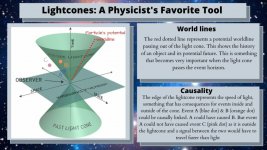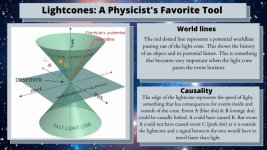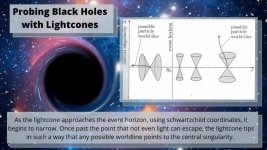Black Holes -- Problem and Solution.
---
Scenario - A
The Milky Way's Monster Black Hole Has a Cool Gas Halo — Literally
By Charles Q. Choi June 05, 2019
------
At the center of our galaxy lies the supermassive black hole
Sagittarius A*, often abbreviated Sgr A*. This giant is about
4 million times the mass of the sun and about 14.6 million
miles (23.6 million kilometers) in diameter.
---
Around Sgr A* swirls a ring of debris known as an accretion disk.
The gas within this disk experiences so much friction that it can
reach 18 million degrees Fahrenheit (10 million degrees Celsius),
according to researchers on the new study. Previous research has
detected X-rays near Sgr A*, likely given off from this hot gas.
---
Prior research suggests that Sgr A* was also surrounded by
relatively cool gas, with temperatures ranging from about
minus 280 degrees F to 17,500 degrees F (minus 170 degrees C
to 10,000 degrees C). However, it remains uncertain how much
cool gas surrounded Sgr A*.
https://www.space.com/milky-way-monster-black-hole-cool-disk.html
---
Scenario - B
1 - A black hole has a temperature within a few
millionths of a degree above absolute zero: T=0K
/ Oxford. Dictionary./
2 - A stellar black hole of one solar mass has a Hawking
temperature of about 100 nanokelvins. This is far less
than the 2.7 K temperature of the cosmic microwave background
http://en.wikipedia.org/wiki/Black_hole
3 - A black hole of one solar mass (M☉) has a temperature
of only 60 nanokelvins (60 billionths of a kelvin)
https://en.wikipedia.org/wiki/Hawking_radiation
4 - September 5, 2016
How cold are black holes?, by Fraser Cain,
---
The most massive black holes in the Universe, the supermassive black holes
with millions of times the math of the Sun will have a temperature of 1.4 x 10-14 Kelvin.
That's low. Almost absolute zero, but not quite.
A solar mass black hole might have a temperature of only .0.00000006 Kelvin.
We're getting warmer.
https://phys.org/news/2016-09-cold-black-holes.html
-----
Problem
"If we want to learn about what processes are important and
not important for how a black hole gets fed, we need to know
the environment around the black hole well," study lead author
Elena Murchikova, an astrophysicist at the Institute for Advanced
Study in Princeton, New Jersey, told Space.com.
"But the contribution of cool gas on a black hole has never
been studied." Now Murchikova and her colleagues suggest
that they may have imaged the cool accretion disk around Sgr A*
for the first time. "This should help improve our understanding
of how accretion onto black holes works," she said.
https://www.space.com/milky-way-monster-black-hole-cool-disk.html
---------
Cold BH - ? Hot BH - ?
Solution
#
What's at the Center of Black Holes?
By Zoë Macintosh June 22, 2010
---
However, no one can know for sure, because
no complete quantum theory of gravity exists,
and the insides of black holes are impossible to observe.
https://www.livescience.com/32662-whats-at-the-center-of-black-holes-.html
#
The puzzles of black hole (as a source with ''gravitational singularity'')
can be solved only with ''Quantum theory of gravity''
===========
---
Scenario - A
The Milky Way's Monster Black Hole Has a Cool Gas Halo — Literally
By Charles Q. Choi June 05, 2019
------
At the center of our galaxy lies the supermassive black hole
Sagittarius A*, often abbreviated Sgr A*. This giant is about
4 million times the mass of the sun and about 14.6 million
miles (23.6 million kilometers) in diameter.
---
Around Sgr A* swirls a ring of debris known as an accretion disk.
The gas within this disk experiences so much friction that it can
reach 18 million degrees Fahrenheit (10 million degrees Celsius),
according to researchers on the new study. Previous research has
detected X-rays near Sgr A*, likely given off from this hot gas.
---
Prior research suggests that Sgr A* was also surrounded by
relatively cool gas, with temperatures ranging from about
minus 280 degrees F to 17,500 degrees F (minus 170 degrees C
to 10,000 degrees C). However, it remains uncertain how much
cool gas surrounded Sgr A*.
https://www.space.com/milky-way-monster-black-hole-cool-disk.html
---
Scenario - B
1 - A black hole has a temperature within a few
millionths of a degree above absolute zero: T=0K
/ Oxford. Dictionary./
2 - A stellar black hole of one solar mass has a Hawking
temperature of about 100 nanokelvins. This is far less
than the 2.7 K temperature of the cosmic microwave background
http://en.wikipedia.org/wiki/Black_hole
3 - A black hole of one solar mass (M☉) has a temperature
of only 60 nanokelvins (60 billionths of a kelvin)
https://en.wikipedia.org/wiki/Hawking_radiation
4 - September 5, 2016
How cold are black holes?, by Fraser Cain,
---
The most massive black holes in the Universe, the supermassive black holes
with millions of times the math of the Sun will have a temperature of 1.4 x 10-14 Kelvin.
That's low. Almost absolute zero, but not quite.
A solar mass black hole might have a temperature of only .0.00000006 Kelvin.
We're getting warmer.
https://phys.org/news/2016-09-cold-black-holes.html
-----
Problem
"If we want to learn about what processes are important and
not important for how a black hole gets fed, we need to know
the environment around the black hole well," study lead author
Elena Murchikova, an astrophysicist at the Institute for Advanced
Study in Princeton, New Jersey, told Space.com.
"But the contribution of cool gas on a black hole has never
been studied." Now Murchikova and her colleagues suggest
that they may have imaged the cool accretion disk around Sgr A*
for the first time. "This should help improve our understanding
of how accretion onto black holes works," she said.
https://www.space.com/milky-way-monster-black-hole-cool-disk.html
---------
Cold BH - ? Hot BH - ?
Solution
#
What's at the Center of Black Holes?
By Zoë Macintosh June 22, 2010
---
However, no one can know for sure, because
no complete quantum theory of gravity exists,
and the insides of black holes are impossible to observe.
https://www.livescience.com/32662-whats-at-the-center-of-black-holes-.html
#
The puzzles of black hole (as a source with ''gravitational singularity'')
can be solved only with ''Quantum theory of gravity''
===========
Attachments
Last edited:





